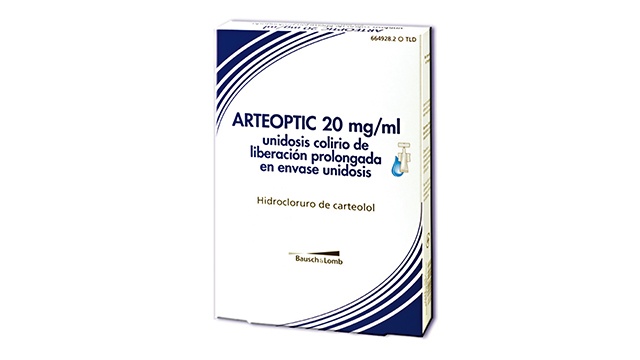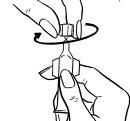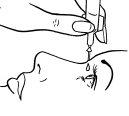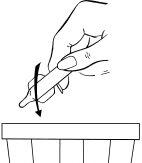

ARTEOPTIC 20 mg/ml COLÍRIO DE LIBERTAÇÃO PROLONGADA EM EMBALAGEM UNIDOSIS

Pergunte a um médico sobre a prescrição de ARTEOPTIC 20 mg/ml COLÍRIO DE LIBERTAÇÃO PROLONGADA EM EMBALAGEM UNIDOSIS

Como usar ARTEOPTIC 20 mg/ml COLÍRIO DE LIBERTAÇÃO PROLONGADA EM EMBALAGEM UNIDOSIS
Introdução
Prospecto: informação para o utilizador
ARTEOPTIC 20 mg/ml unidose colírio de libertação prolongada em embalagem unidose
Hidrocloruro de carteolol
Leia todo o prospecto detenidamente antes de começar a usar este medicamento, porque contém informações importantes para si.
- Conserva este prospecto, porque pode ter que voltar a lê-lo.
- Se tiver alguma dúvida, consulte o seu médico ou farmacêutico.
- Este medicamento foi-lhe prescrito apenas para si, e não deve dá-lo a outras pessoas, ainda que tenham os mesmos sintomas que si, porque pode prejudicá-las.
- Se experimentar efeitos adversos, consulte o seu médico ou farmacêutico, mesmo que se trate de efeitos adversos que não aparecem neste prospecto. Ver secção 4.
Conteúdo do prospecto
- O que é ARTEOPTIC em embalagem unidose e para que é utilizado
- O que necessita de saber antes de começar a usar ARTEOPTIC em embalagem unidose.
- Como usar ARTEOPTIC em embalagem unidose
- Possíveis efeitos adversos
- Conservação de ARTEOPTIC em embalagem unidose.
- Conteúdo da embalagem e informações adicionais
1. O que é ARTEOPTIC em embalagem unidose e para que é utilizado
ARTEOPTIC pertence a uma classe de medicamentos chamada betabloqueantes.
É utilizado para o tratamento local das seguintes doenças oculares:
- Certa forma de glaucoma (glaucoma crónico de ângulo aberto).
- Aumento da pressão nos olhos (hipertensão intraocular).
2. O que necessita de saber antes de começar a usar ARTEOPTIC em embalagem unidose
Não deve utilizar ARTEOPTIC em embalagem unidose
- Se sofre de alergia ao hidrocloruro de carteolol ou a qualquer um dos outros componentes deste medicamento (incluídos na secção 6).
- Se sofre ou sofreu no passado de doenças respiratórias como asma, bronquite obstructiva crónica grave (doença grave dos pulmões que pode produzir sibilancias, dificuldade para respirar e/ou tosse a longo prazo).
- Se sofre de batimento cardíaco lento, falha cardíaca ou alterações do ritmo cardíaco (batimento cardíaco irregular)
- Se tem bradicardia (pulso menor de 45 - 50 batimentos por minuto).
- Se tem um feocromocitoma não tratado (produção excessiva de hormonas que causa um aumento da tensão arterial grave).
Advertências e precauções
Consulte o seu médico, farmacêutico ou enfermeiro antes de começar a usar ARTEOPTIC. Se tem ou teve no passado:
- Doença coronária (sintomas que podem incluir dor de peito ou debilidade, fadiga ou asfixia), falha cardíaca, diminuição da pressão sanguínea,
- alterações das fases cardíacas como bradicardia (batimento cardíaco lento),
- problemas respiratórios, asma ou doença pulmonar obstructiva crónica (doença pulmonar que pode causar sibilancias, dificuldade em respirar e/ou tosse a longo prazo),
- alteração da circulação periférica (doença de Raynaud ou síndrome de Raynaud),
- diabetes dado que carteolol pode mascarar os sinais e sintomas de um nível baixo de açúcar no sangue,
- a diabetes pode mascarar os sinais e sintomas de um nível baixo de açúcar no sangue (hipoglicemia),
- o carteolol pode mascarar os sinais e sintomas da hiperatividade da glândula tireoide,
- feocromocitoma tratado,
- psoríase,
- doença corneal,
- histórico de reações alérgicas,
- doença renal ou hepática
Informa ao seu médico que está a tomar ARTEOPTIC antes de se submeter a uma anestesia dado que o carteolol pode alterar os efeitos de alguns medicamentos durante a anestesia.
Para controlar que não está a desenvolver uma resistência à eficácia terapêutica deste produto, quando usar este medicamento deve ser submetido a exames oftalmológicos periódicos no início do tratamento e posteriormente, aproximadamente cada 4 semanas. Além disso, em caso de tratamento a longo prazo, os exames devem controlar se se produz um fracasso do tratamento (perda de eficácia do medicamento).
Se utiliza lentes de contacto: uma inibição da produção de lágrimas possivelmente relacionada com esta classe de medicamentos pode produzir um risco de intolerância nos utilizadores de lentes de contacto.
Se sofre danos graves na córnea (a camada transparente da parte frontal do olho), o tratamento com fosfatos, em caso muito raros, pode causar visão borrosa por acumulação de cálcio.
O princípio ativo deste medicamento pode produzir um resultado positivo nas provas de controlo antidopagem.
Crianças e adolescentes
Este colírio não deve ser utilizado em bebés prematuros ou recém-nascidos, nem em crianças nem adolescentes.
Uso de ARTEOPTIC em embalagem unidose com outros medicamentos
ARTEOPTIC pode afetar ou ser afetado por outros medicamentos quando estão a ser utilizados, incluindo outros colírios para o tratamento do glaucoma.
- Se está a utilizar outros medicamentos de aplicação no olho, deve:
- Aplicar o outro medicamento oftálmico
- Esperar 15 minutos
- Aplicar ARTEOPTIC por último
- Seu médico pode também prescrever-lhe um colírio miótico para o tratamento de certo tipo de glaucoma (como o glaucoma de ângulo fechado).
- É necessário um seguimento oftalmológico se utilizar um colírio de adrenalina/epinefrina ao mesmo tempo que ARTEOPTIC (devido ao risco de dilatação da pupila).
- Se tomar betabloqueantes orais ao mesmo tempo, é frequentemente necessário ajustar a dose de ARTEOPTIC.
Embora a quantidade de betabloqueante que chega ao sangue após a aplicação nos olhos seja baixa, deve ter em conta as interações que se têm observado com os betabloqueantes orais:
- Não se recomenda a utilização de amiodarona (utilizada para o tratamento das alterações do ritmo cardíaco), de certos antagonistas do cálcio (utilizados para o tratamento da hipertensão, como diltiazem, fingolimod, ozanimod e verapamilo) ou de outros betabloqueantes (utilizados para o tratamento da insuficiência cardíaca).
- Todos os betabloqueantes podem mascarar certos sintomas de hipoglicemia: palpitações e taquicardia.
- Pode aumentar o nível no sangue de Lidocaína (administrada por via IV), o que aumentaria o risco de efeitos adversos cardíacos e neurológicos.
Quando se utilizar mais de um medicamento oftálmico tópico, as administrações de fármacos devem ser espaçadas pelo menos 15 minutos. As pomadas oculares devem ser administradas por último.
Informa ao seu médico se está a utilizar ou vai a utilizar medicamentos para diminuir a pressão sanguínea, medicamentos para o coração, medicamentos para tratar a diabetes ou esclerose múltipla.
Informa ao seu médico ou farmacêutico se está a utilizar ou utilizou recentemente outros medicamentos, mesmo os adquiridos sem receita. Eles farão um seguimento específico se for necessário.
Gravidez e lactação
Se está grávida ou em período de lactação, acredita que possa estar grávida ou tem intenção de engravidar, consulte o seu médico ou farmacêutico antes de utilizar este medicamento.
Gravidez
Não utilize ARTEOPTIC se está grávida a não ser que o seu médico considere que é necessário.
Não existem dados adequados sobre o uso de Hidrocloruro de Carteolol em mulheres grávidas.
Para diminuir a absorção sistémica ver secção 3.
Lactação
Não utilize ARTEOPTIC se está a amamentar. O hidrocloruro de carteolol pode passar para o leite materno.
Os betabloqueantes são excretados pelo leite materno. No entanto, às doses terapêuticas do colírio de Hidrocloruro de Carteolol, não é provável que haja quantidades suficientes no leite materno para produzir sintomas clínicos de betabloqueio em crianças. Para reduzir a absorção sistémica ver secção 3.
Pergunte ao seu médico antes de tomar qualquer medicamento durante a lactação.
Condução e uso de máquinas
Após a aplicação deste produto nos olhos pode aparecer visão borrosa.
Não conduza nem utilize máquinas até que tenha recuperado a visão normal.
ARTEOPTIC em embalagem unidose contém tampão fosfato
Este medicamento contém 0,049 mg de fosfatos em cada gota que equivalen a 1,4 mg/ml.
3. Como usar ARTEOPTIC em embalagem unidose
Este medicamento deve ser administrado nos olhos (via oftálmica).
Siga exatamente as instruções de administração deste medicamento indicadas pelo seu médico. Em caso de dúvida pergunte ao seu médico ou farmacêutico.
ARTEOPTIC contém um excipiente específico que possui propriedades físicas que permitem uma única administração por dia.
A dose recomendada é uma gota no olho ou nos olhos afetados, uma vez por dia, pela manhã.
No entanto, o seu médico pode decidir ajustar a dose, especialmente se está a tomar betabloqueantes orais (pela boca) ao mesmo tempo (veja secção 2 “Uso de outros medicamentos”).
Instruções de uso
- Se usa lentes de contacto, deve retirá-las antes de aplicar ARTEOPTIC e esperar 15 minutos antes de voltar a colocá-las.
- Para uma administração correcta de ARTEOPTIC:
- Lave as mãos cuidadosamente antes de aplicar as gotas.
- Antes de cada nova utilização, separe um embalagem unidose da tira.
- Gire o extremo do frasco para abrir o embalagem unidose. Coloque o embalagem unidose boca abaixo, golpeie ligeiramente o corpo do frasco unidose para fazer com que a solução se desloque para a abertura.
- Evite tocar o olho ou a pálpebra com o bordo do embalagem.
- Para o tratamento, puxe suavemente a pálpebra inferior e instile uma gota enquanto olha para cima.
- Após a administração, feche o olho durante alguns segundos.
- Com o olho fechado, limpe suavemente qualquer quantidade em excesso.
- Após a administração de ARTEOPTIC, pressione com o dedo no ângulo do olho próximo ao nariz durante 2 minutos. Isso evita que a substância activa (carteolol) passe para o resto do organismo.
- Com os olhos fechados, descarte qualquer excesso de medicamento.
- Descarte o embalagem unidose imediatamente após a sua utilização.
- Não use o conteúdo de embalagens unidose já abertas ou iniciadas.
- A quantidade de gotas de um embalagem é suficiente para o tratamento dos dois olhos.
Separar Girar o tampão para abri-lo
Girar o tampão para abri-lo
Inverter o embalagem completamente Instile no olho
Instile no olho
Jogue fora após o uso
- Se está a utilizar outro medicamento que se aplica no olho, deve:
- Administrar-se primeiro o outro medicamento oftálmico
- Esperar 15 minutos
- Por último, aplicar ARTEOPTIC
- Se o seu médico lhe prescreveu ARTEOPTIC em substituição de outro medicamento, deve interromper a utilização do outro colírio no final de um dia completo de tratamento.
- Comece o tratamento com ARTEOPTIC no dia seguinte, à dosagem que o seu médico lhe indicou.
- Se estima que a acção de ARTEOPTIC é demasiado forte ou débil, comunique-o ao seu médico ou farmacêutico.
Não injete nem engula.
Duração do tratamento
Siga as instruções do seu médico. Ele lhe dirá quanto tempo tem que utilizar ARTEOPTIC. Não interrompa o tratamento antes.
Se usa mais ARTEOPTIC em embalagem unidose do que deve:
Se administra demasiadas gotas nos olhos, lave-os com água limpa.
Em caso de administração oral acidental do conteúdo do embalagem, podem aparecer certos efeitos secundários como sensação de cabeça oca, dificuldade para respirar ou impressão de que o pulso é mais lento.
Em caso de sobredose ou ingestão acidental, consulte imediatamente o seu médico ou farmacêutico ou ligue para o Serviço de Informação Toxicológica Tel. (91) 562 04 20.
Se esqueceu de utilizar ARTEOPTIC em embalagem unidose
Não utilize uma dose dupla para compensar a dose esquecida.
Se interrompeu o tratamento com ARTEOPTIC em embalagem unidose
Se interrompeu o tratamento pode aumentar a pressão intraocular dos seus olhos e provocar-lhe visão borrosa.
Não interrompa nunca o tratamento sem consultar primeiro o seu médico ou farmacêutico.
Se tiver alguma outra dúvida sobre o uso deste medicamento, pergunte ao seu médico ou farmacêutico.
4. Possíveis efeitos adversos
Como todos os medicamentos, este medicamento pode produzir efeitos adversos, embora nem todas as pessoas os sofram.
Geralmente pode continuar a aplicar o colírio, a menos que os efeitos sejam graves. Se está preocupado, consulte o seu médico ou farmacêutico. Não deixe de utilizar ARTEOPTIC sem informar o seu médico.
Como outros medicamentos administrados nos olhos (medicamentos oftálmicos administrados topicamente), ARTEOPTIC pode ser absorvido e passar para o sangue. Isso pode produzir os efeitos secundários que se observam com betabloqueantes sistémicos. A frequência de efeitos adversos após a administração tópica nos olhos é inferior que com outros medicamentos administrados por via oral ou injetável. Os efeitos adversos listados a seguir incluem reações adversas vistas com outros agentes betabloqueantes oftálmicos:
A frequência dos seguintes efeitos adversos é frequente (pode afetar até 1 de cada 10 pessoas)
- Sinais e sintomas de irritação ocular (por exemplo, queimadura), dor no olho (por exemplo, coceira), sensação de picar, inchaço, lagrimeo, olhos vermelhos, vermelhidão da conjuntiva, conjuntivite, irritação ou sensação de ter algo estranho no olho (queratite).
- Alterações do gosto.
A frequência dos seguintes efeitos adversos é pouco frequente (pode afetar até 1 de cada 100 pessoas).
- Tonturas
- Debilidade muscular ou dor não produzida por exercício (mialgia), cãibras musculares.
A frequência dos seguintes efeitos adversos é rara (pode afetar até 1 de cada 1.000 pessoas)
- Resultados positivos de anticorpos antinucleares.
Em casos muito raros, alguns pacientes com danos graves na camada transparente da parte frontal do olho (córnea) desenvolveram opacidade corneal devido a depósitos de cálcio durante o tratamento.
A frequência dos seguintes efeitos adversos é desconhecida (a frequência não pode ser estimada a partir dos dados disponíveis
- Reações alérgicas incluindo inchaço súbito da face, lábios, boca, língua ou garganta que podem causar problemas para respirar ou engolir, erupção cutânea, rash localizado e generalizado, coceira, reação alérgica que põe a vida em perigo de modo repentino.
- Níveis baixos de açúcar no sangue
- Dificuldade para dormir (insónia), depressão, pesadelos, diminuição da libido.
- Desmaio, infarto, diminuição do fluxo sanguíneo em algumas partes do cérebro, aumento em sinais e sintomas de miastenia gravis (alteração muscular), formigamento ou adormecimento das mãos e pés, coceira, dor de cabeça, perda de memória.
- Pálpebras inchadas (blefarite), visão borrosa, sensibilidade corneal diminuída após uma operação oftálmica (desprendimento coroidal após cirurgia de filtração), diminuição da sensibilidade corneal, olhos secos, dano na camada frontal do globo ocular (erosão corneal), queda da pálpebra superior ou inferior, visão dupla, alterações na refração (às vezes devido à retirada do tratamento com gotas mióticas).
- Batimento cardíaco lento, palpitações, alterações no ritmo ou na velocidade do batimento cardíaco, doença cardíaca com dificuldade para respirar e inchaço dos pés e pernas devido à acumulação de líquido (falha cardíaca congestiva), condição cardíaca (bloqueio atrioventricular), ataque cardíaco, insuficiência cardíaca.
- Pressão sanguínea baixa Fenómeno de Raynaud, mãos e pés frios, cãibras e/ou dor de pernas ao andar (claudicação).
- Broncoespasmo (dificuldade para respirar ou silbidos - predominantemente em pacientes com doença broncoespástica pré-existente), falta de ar (dispnéia), tosse.
- Náuseas, indigestão, diarreia, secura da boca, dor abdominal, vómitos.
- Perda de cabelo, rash cutâneo com aparência de cor prateada branca (rash psoriforme) ou piora da psoríase, erupções cutâneas.
- Lúpus sistémico eritematoso.
- Disfunção sexual, impotência.
- Debilidade muscular incomum ou dor não produzida por exercício (astenia) ou cansaço, dor de peito, acumulação de líquido (edema).
Comunicação de efeitos adversos:
Se experimenta qualquer tipo de efeito adverso, consulte o seu médico, farmacêutico ou enfermeiro, mesmo que se trate de possíveis efeitos adversos que não aparecem neste prospecto. Também pode comunicá-los directamente através do sistema Espanhol de Farmacovigilância de medicamentos de Uso Humano: https://www.noficaram.es. Mediante a comunicação de efeitos adversos, você pode contribuir para fornecer mais informações sobre a segurança deste medicamento.
5. Conservação de ARTEOPTIC em embalagem unidose
- Mantenha este medicamento fora da vista e do alcance das crianças.
- Não utilize este medicamento após a data de caducidade que aparece no embalagem após “EXP” (siglas em inglês de caducidade). A data de caducidade é o último dia do mês que se indica.
- Não conserve a temperatura superior a 25ºC.
- Deve ser descartado após 28 dias da primeira abertura do frasco.
- Não utilize se o fecho está deteriorado.
Os medicamentos não devem ser jogados fora pelos esgotos nem para o lixo. Deposite os embalagens e os medicamentos que não precisa no Ponto SIGRE da farmácia. Em caso de dúvida, pergunte ao seu farmacêutico como se livrar dos embalagens e dos medicamentos que não precisa. Dessa forma, ajudará a proteger o meio ambiente.
6. Conteúdo do envase e informação adicional
Composição de ARTEOPTIC 2% colírio de libertação prolongada em envase unidose
- O princípio ativo é:hidrocloruro de carteolol.
ARTEOPTIC 20 mg/ml: cada ml de colírio contém 20 mg de hidrocloruro de carteolol ou cada envase unidose (0,2 ml) contém 4 mg de hidrocloruro de carteolol.
- Os demais componentes são:dihidrogenofosfato de sódio dihidrato, fosfato disódico dodecahidrato, cloruro de sódio, ácido alginico, hidróxido de sódio (para ajustar o pH) e água purificada.
Aspecto do produto e conteúdo do envase
Este medicamento é um beta-bloqueante de uso ocular.
ARTEOPTIC 20 mg/ml colírio de libertação prolongada se apresenta em forma de solução transparente e ligeiramente amarelo-marrom envasada em tiras de envases unidose de 0,2 ml e acondicionadas em um sobre (poliéster/ alumínio/ polietileno).
Envase de 30 envases unidose.
Pode ser que apenas alguns tamanhos de envases estejam comercializados
Titular da autorização de comercialização e responsável pela fabricação
Titular da autorização de comercialização:
BAUSCH + LOMB IRELAND LIMITED
3013 Lake Drive
Citywest Business Campus
Dublin 24, D24PPT3
Irlanda
Responsável pela fabricação:
Laboratoire CHAUVIN
Zone Industrielle Ripotier Haut - 07200 Aubenas
França
Representante local:
Bausch&Lomb S.A.
Avda. Valdelaparra nº4
28108 Alcobendas (Madrid)
Este medicamento está autorizado nos Estados-Membros do Espaço Económico Europeu com os seguintes nomes:
França: Carteol L.P 1% e Carteol L.P 2% colírios à libertação prolongada em recipiente unidose
Portugal: Physioglau 1% e Physioglau 2% colírio de libertação prolongada, recipiente para dose única.
Itália: Fortinol 1% & 2% monodose, colírio a rilascio prolungato, contenitore monodose.
Espanha: ARTEOPTIC 20 mg/ml, colírio de libertação prolongada, envases unidose.
Data da última revisão deste prospecto:Fevereiro 2023
A informação detalhada e atualizada sobre este medicamento está disponível na página Web da Agência Espanhola do Medicamento e Produtos Sanitários (AEMPS) http://www.aemps.gob.es/

Quanto custa o ARTEOPTIC 20 mg/ml COLÍRIO DE LIBERTAÇÃO PROLONGADA EM EMBALAGEM UNIDOSIS em Espanha em 2025?
O preço médio do ARTEOPTIC 20 mg/ml COLÍRIO DE LIBERTAÇÃO PROLONGADA EM EMBALAGEM UNIDOSIS em dezembro de 2025 é de cerca de 3.81 EUR. Os valores podem variar consoante a região, a farmácia e a necessidade de receita. Confirme sempre com uma farmácia local ou fonte online para obter informações atualizadas.
- País de registo
- Preço médio em farmácia3.81 EUR
- Disponibilidade em farmáciasProblema de disponibilidade reportado
- Substância ativa
- Requer receita médicaSim
- Fabricante
- Esta informação é apenas para referência e não constitui aconselhamento médico. Consulte sempre um médico antes de tomar qualquer medicamento. A Oladoctor não se responsabiliza por decisões médicas baseadas neste conteúdo.
- Alternativas a ARTEOPTIC 20 mg/ml COLÍRIO DE LIBERTAÇÃO PROLONGADA EM EMBALAGEM UNIDOSISForma farmacêutica: COLÍRIO DE LIBERTAÇÃO PROLONGADA, 10 mg cloridrato de carteolol/mlSubstância ativa: carteololFabricante: Bausch + Lomb Ireland LimitedRequer receita médicaForma farmacêutica: COLÍRIO DE LIBERTAÇÃO PROLONGADA, 20 MG/MLSubstância ativa: carteololFabricante: Bausch + Lomb Ireland LimitedRequer receita médicaForma farmacêutica: NULL, 20 mg/mlSubstância ativa: carteololFabricante: Bausch + Lomb Ireland LimitedRequer receita médica
Alternativas a ARTEOPTIC 20 mg/ml COLÍRIO DE LIBERTAÇÃO PROLONGADA EM EMBALAGEM UNIDOSIS noutros países
As melhores alternativas com o mesmo princípio ativo e efeito terapêutico.
Alternativa a ARTEOPTIC 20 mg/ml COLÍRIO DE LIBERTAÇÃO PROLONGADA EM EMBALAGEM UNIDOSIS em Polónia
Médicos online para ARTEOPTIC 20 mg/ml COLÍRIO DE LIBERTAÇÃO PROLONGADA EM EMBALAGEM UNIDOSIS
Avaliação de posologia, efeitos secundários, interações, contraindicações e renovação da receita de ARTEOPTIC 20 mg/ml COLÍRIO DE LIBERTAÇÃO PROLONGADA EM EMBALAGEM UNIDOSIS – sujeita a avaliação médica e regras locais.














